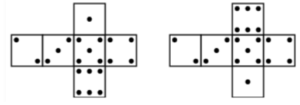A classic die is a cube with dots (pips) ranging from one to six placed on each of its six faces. The die, when thrown or rolled, comes to rest with a random number from one to six written on its upper surface, with each value having an equal chance of occurring. Dice can also have irregular or polyhedral forms, and their faces might be marked with numbers or symbols rather than pips. To facilitate cheating or for amusement, loaded dice are made to favour particular outcomes over others.
Classification of Dice:
Dice is a cube with unique numbers on each face. Typically, the numerals are just one digit, ranging from 1 to 6.
A die has a particular numbering system. The total of the numbers on the opposing faces will always equal “7.” Number 1 will be next to number 6, in opposition. Both the number 2 and the number 3 are opposed to the number 5. like that
1+6=7
2+5=7
3+4=7

Dice numbering system
Dice classification
Two distinct dice kinds exist.
- Standard dice
- Ordinary dice
Standard Dice
When the dice are rolled, the two dice are referred to be standard dice if the numbers on their faces do not match.
Ordinary Dice
Two dice are considered to be regular dice if one or more numbers match on them.
Use of Dice
Either from the hand or from a special container, dice are tossed onto a surface (such as a cup or tray). The value of the throw is determined by which die face is on top when it comes to rest.
According to the principles of classical mechanics, the manner in which a die is thrown affects the outcome of a roll. Die rolls are a rudimentary type of hardware random number generator because they are made random by uncertainty in minor parameters like the thrower’s modest hand motions.
Craps is a common dice game played today, in which bets are place on the combined value of two dice that are thrown simultaneously. Dice are widely used in board games to add unpredictability, and they are usually used to determine how far a piece will advance across the board.
Arrangement
Common dice are little cubes, typically 1.6 cm (0.63 in) wide, with numbers 1–6 written on their faces, typically in patterns of round dots called pips. (Although Arabic numerals are occasionally used, these dice are less frequent.)
The 1, 2, and 3 faces of a contemporary die must share a vertex in order for the opposite sides to sum up to seven. A die’s faces can be arranged around this vertex either clockwise or counter clockwise. The die is referred to as “right-handed” if the 1, 2, and 3 faces are oriented counter clockwise. The die is referred to as “left-handed” if those faces face clockwise. Chinese dice are often left-handed, while Western dice are typically right-handed.
On typical six-sided dice, the pips are placed in the manner depicted. Western and Asian dice have designs that are similar, but Asian dice have pips that are larger and coloured red on the 1 and 4 sides. Asian dice also have pips that are closer to the centre of the face. Red Fours could have Indian ancestry.
Manufacturing
Plastic injection moulding is used to create non-precision dice, which are frequently constructed of polymethyl methacrylate (PMMA). The die’s pips or numbers are a component of the mould. The dice can be coloured with various pigments to make them opaque or translucent, or with a variety of colours to give them a marbled or speckled appearance.
The die is completely covered with paint, which is then allowed to dry, to create the colouring needed for numbering. After that, the die is polished using a tumble finishing technique that is related to rock polishing. All of the paint is removed by the abrasive substance, but the numerical indents remain painted. The die is then polished with a finer abrasive. The smoother, rounder edges of the dice are also produced by this technique.
Deconstructed Dice definition
Deconstructed Dice: This portion of dice presents the flattened-out form of dice; the questions will be based on a visualisation of what is on the other end of the built dice. Changing from a flat end to a built die
Conclusion
Dice are widely used in board games to add unpredictability, and they are usually used to determine how far a piece will advance across the board. To facilitate cheating or for amusement, loaded dice are made to favour particular outcomes over others. The die is then polished with a finer abrasive. The smoother, rounder edges of the dice are also produced by this technique.
 Profile
Profile Settings
Settings Refer your friends
Refer your friends Sign out
Sign out








